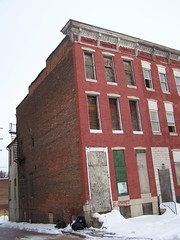Leaving Baltimore? Baltimore's already been abandoned by many!
I think this is on East Lanvale Street, but it could be Layfayette Street, within 7 blocks of Baltimore's Penn Station. About half the buildings in the area have been vacant for decades. Many lots are empty, the houses that once stood on the lots having been demolished at some point in the recent past.
So whether or not there is a slight demographic change in the composition of outmigration from Baltimore--the Baltimore Sun reports, in "A new exodus" that African-American outmigration from Baltimore City is now exceeding white outmigration, doesn't change things very much.
People are still leaving. Otherwise you wouldn't have thousands upon thousands of vacant buildings and lots in a goodly portion of Baltimore City.
And frankly, this change in the composition of outmigration doesn't surprise me. Attitudes and behaviors that favor urban living in most center cities outside of New York City tend to lag amongst African-Americans. Much of the in-migration to DC over the past 20 years has been countered by African-American outmigration to Maryland, especially to Prince George's and Charles Counties, which are now majority African-American.
For old discussion on this, see the blog entry from 2006, Commerz in the 'hood... (aka "Commerce as the engine of urbanism").
Colbert King, the Saturday op-ed columnist in the Washington Post got around to writing about this over the weekend. In "D.C.'s changing face" where he writes that changes in municipal government since Mayor Williams (1998) and continued under Mayor Fenty have been in response to the fact that in-migration into the city has mostly been a white (and Hispanic) phenomenon, that African-Americans continue to leave the city, and in order to retain higher income residents, the government has to be managed differently and address issues differently.
From the article:
In the past 10 years, the District has become more ethnically diverse and, probably, less straight. Urban pioneers have become settled homeowners and are having babies. And the face of Washington is filling out, too. For the first time in nearly two decades, the District has nearly 600,000 residents.
The 10-year growth spurt has brought in residents with more income and education. Over that same time, two once-influential D.C. institutions -- labor unions and black churches -- have been relegated to marginal positions in city life. Both are casualties of black flight to the suburbs.
Union and church members, once rich sources of votes in the city's eight political wards, are now in "Ward 9": the domicile of former D.C. residents who work and worship in the city by day but live, vote and play in the suburbs by night.
It's not far-fetched to say that the city's power center is shifting from longtime residents to the newly arrived, meaning those who have moved in over the past 10 years or so.
The political story of the decade, largely unreported, is how a succession of mayors has recognized and tried to accommodate the changes they saw coming -- changes driven more by economics than by race. The simple truth: People moving in have the bucks to buy.
That's where Baltimore is also lagging DC... but if the city can get its management right, and its transit right--the new Downtown Circulator bus system, which will be free, is launching this week--it has the opportunity to right its downward trajectory.
Actually, King is wrong in that this story hasn't been reported. It has been reported in every whiny Post article about neighborhood change, such as the articles mentioned in the beginning of the Commerz in the 'hood entry:
-- A Bittersweet Renaissance (Shaw)
-- Letters to the editor in response, A Disturbing Snapshot Of Shaw
-- One Urban Panorama Fades, Another Rises (14th and T Streets NW, part one)
-- A Boom Giveth, and It Taketh Away (14th and T Streets NW, part two)
-- Whose H Street Is It, Anyway?
These articles were all about changes in neighborhoods, both in terms of new residents, and in the perceptions of current residents about these changes. The past 20 years of reporting in the Post on DC issues has been about this change in the city.
Also see the past blog entries:
- Bringing buildings back is really about bringing urban neighborhoods back
- Is this the fifth phase of center city revitalization? (since World War II)
Labels: demographics, urban revitalization




0 Comments:
Post a Comment
<< Home